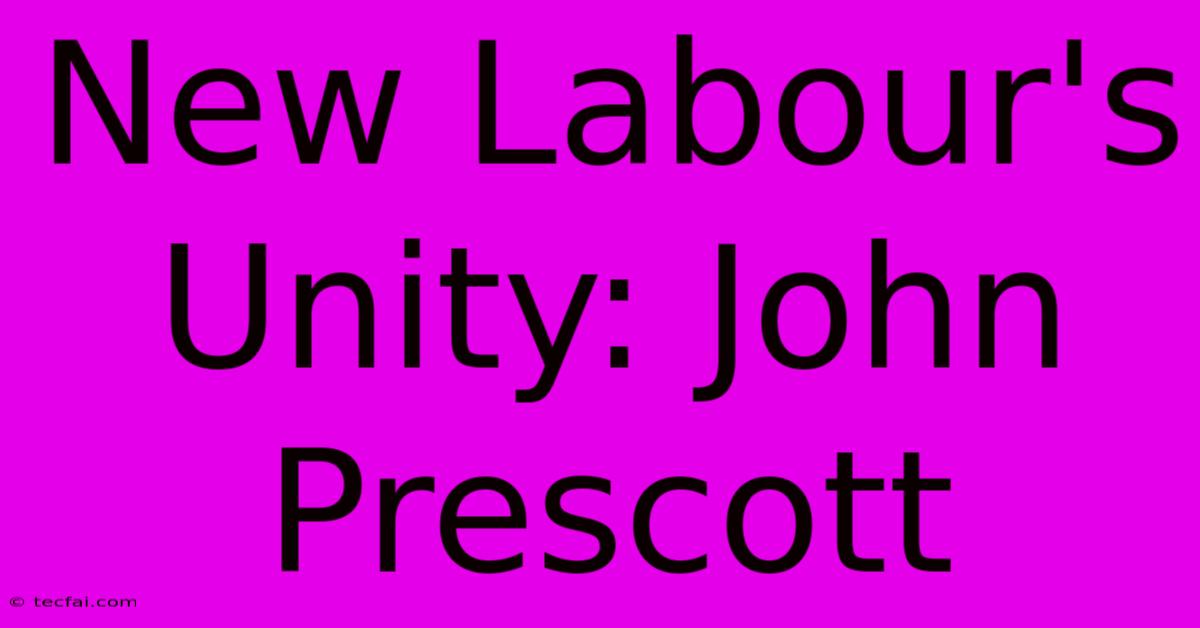New Labour's Unity: John Prescott

Discover more detailed and exciting information on our website. Click the link below to start your adventure: Visit Best Website tecfai.com. Don't miss out!
Table of Contents
New Labour's Unity: The John Prescott Paradox
John Prescott. The name alone conjures strong reactions. For many, he remains a potent symbol of New Labour's era – a time of significant social and political change in the UK. But Prescott's legacy is complex, a fascinating blend of unwavering loyalty to Tony Blair, undeniable political clout, and a personality that often overshadowed the policies he championed. This article explores Prescott's role in forging and maintaining New Labour's unity, highlighting both his contributions and the inherent contradictions within his persona.
The Architect of Unity?
Prescott's importance to New Labour's unity cannot be overstated. He was, arguably, the bridge between the party's different factions. A seasoned trade unionist with a working-class background, he held significant sway within the party's more traditional left wing. Yet, he wholeheartedly embraced Blair's "Third Way" – a centrist approach that deliberately sought to distance itself from traditional socialist dogma. This acceptance, while seemingly paradoxical, was crucial in preventing internal fracturing. His presence helped reassure those wary of Blair's modernizing agenda that their concerns were understood and addressed within the new leadership.
Beyond the "Bluster": A Pragmatic Approach
Prescott's public image – often characterized by robust pronouncements and occasional gaffes – sometimes obscured his significant political skills. He was a master negotiator, skilled at navigating the internal complexities of the party. His ability to build consensus, even amongst those with vastly differing political viewpoints, was a key factor in New Labour's ability to remain cohesive throughout its time in power. This wasn't simply a matter of charisma; it was a calculated strategy aimed at maintaining party discipline and avoiding damaging public splits.
Deputy Prime Minister: A Powerful Voice
As Deputy Prime Minister, Prescott wielded considerable influence. He was a key player in shaping government policy on issues such as transport and regional development. His commitment to regional equality, embodied in the creation of regional development agencies, reflected his working-class roots and fostered a sense of inclusivity within the party. This commitment to regional balance, often overlooked in the focus on national policy, helped maintain a sense of unity within a diverse party.
The Challenges to Unity: Internal Tensions
While Prescott played a crucial role in fostering unity, it wasn't without its challenges. The inherent tensions between the different factions within New Labour – the traditional left, the centrists, and the Blairites – were always present. Prescott's own political positioning, a careful balance between loyalty to Blair and representation of the party's left wing, was a constant tightrope walk. Internal debates over policy, particularly those regarding the Iraq War, tested the limits of the party's unity, and Prescott's role in managing these tensions was undoubtedly demanding.
Prescott's Legacy: A Contested Narrative
Prescott's legacy remains a subject of debate. Some celebrate him as a key figure in New Labour's electoral success and a champion of social justice. Others criticize his perceived lack of political finesse and his association with some of the more controversial aspects of New Labour's policies. However, irrespective of individual opinions, his role in navigating the internal complexities of the party and in contributing to its unity during a period of significant political transformation is undeniable. He was a vital cog in the New Labour machine, a complex figure whose impact continues to shape discussions about the party's history.
Keywords: John Prescott, New Labour, Tony Blair, Deputy Prime Minister, British Politics, Third Way, Political Unity, Labour Party, British History, Political Strategy, Social Justice, Regional Development
Related Searches: John Prescott controversies, New Labour legacy, Third Way politics, British political history, Labour party factions.

Thank you for visiting our website wich cover about New Labour's Unity: John Prescott. We hope the information provided has been useful to you. Feel free to contact us if you have any questions or need further assistance. See you next time and dont miss to bookmark.
Featured Posts
-
Uk Methanol Deaths Lawyer Among Victims
Nov 22, 2024
-
Ex Boss On Captain Tom Charity Fraud
Nov 22, 2024
-
Wise Tech Agm Key Issues Friday
Nov 22, 2024
-
Burghart Defeats Labour On Farm Tax In Pmqs
Nov 22, 2024
-
Get The Oura Ring Big Price Drop
Nov 22, 2024
